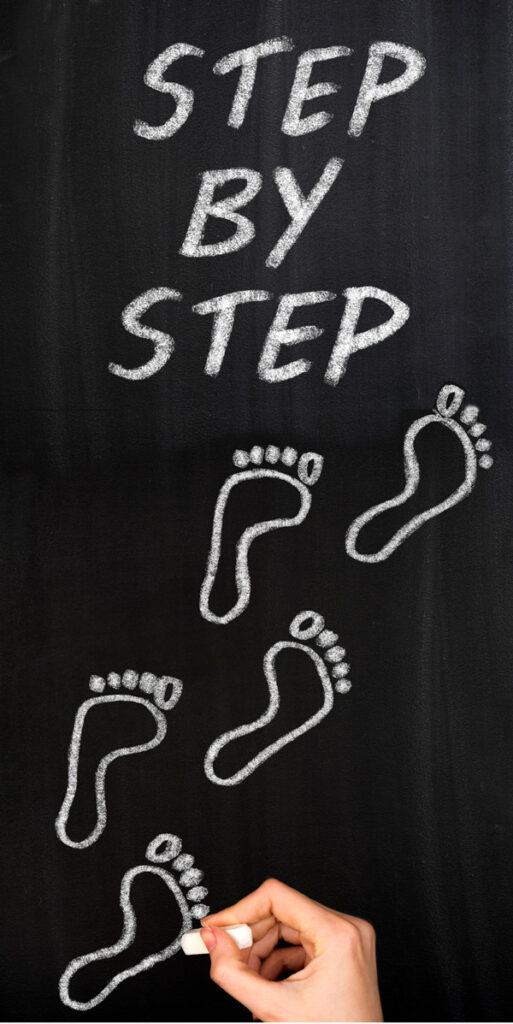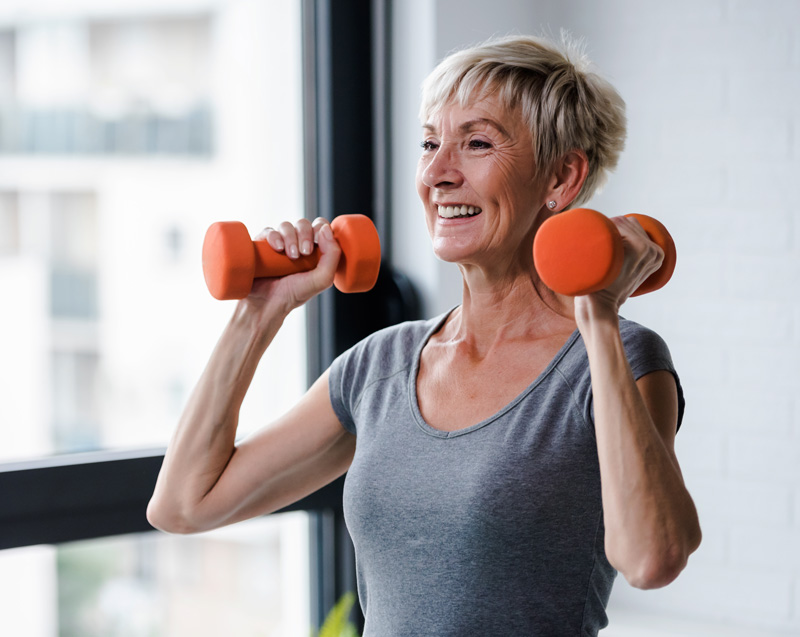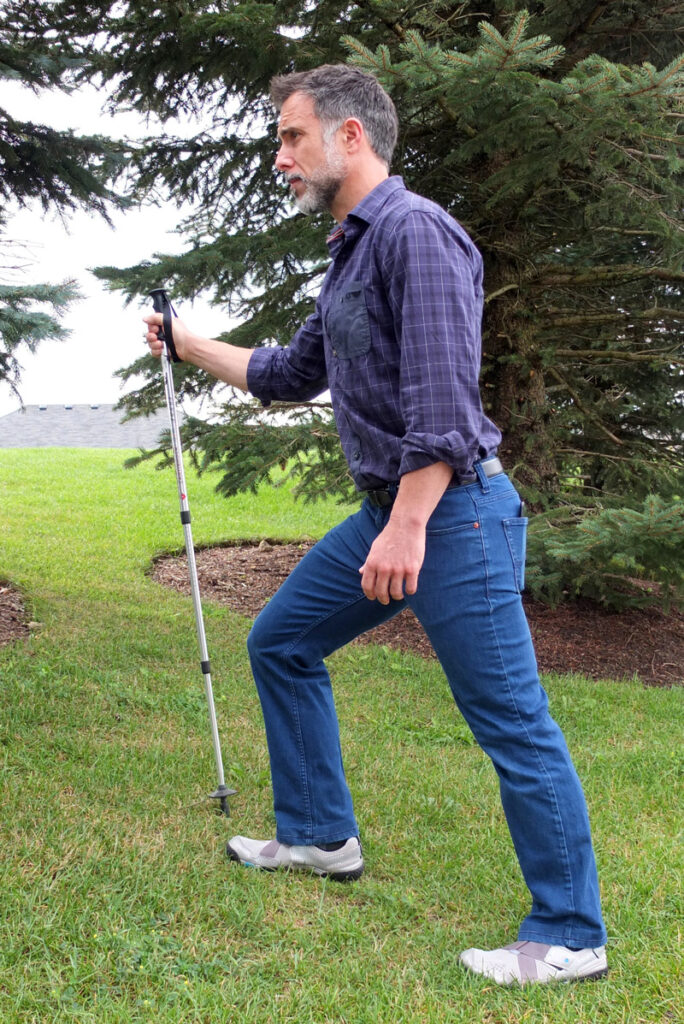Movement & Exercise
Being able to move without pain- in order to stay active and participate in all aspects of our daily activities can be a challenge.
But- because we have not been able to use our muscles and joints efficiently for quite some time, it is important to CHANGE our ideas about movement and exercise.
We need to develop some NEW exercise guidelines.
This information – and these guidelines apply to everyone– from the person experiencing persistent pain most of the time, to the athlete- who may ‘occasionally’ get into difficulties by ‘Going to the Ouch!’
It is physically impossible to get stronger and build endurance if we are always in pain. (and how can we go on that hiking trip unless we ‘get into shape’ ?).
Consider this Section, your Step- by- Step approach to getting stronger and more fit. It is important to work through each of these steps- as you move from pain/symptom control to gaining range of motion to increasing strength.


Control the Pain/Symptoms 
- That does not mean that you have absolutely no discomfort
- But it does mean that the feeling is localized in the area you want to move.
- “If I am doing an arm exercise, I want to only feel the muscle work in my arm muscles, not in my neck or shoulder blade area”
- Be aware that you may have other than ouchy feelings to control- like nausea , dizziness, or ? in addition to the persistent pain problem.
- You may have to modify your exercise program- and progress slower than you would like, because each
 may be sending you another message.
may be sending you another message. - Control also means, learning when to stop, to take a rest, and to modify or change the position
Stretch – improve range of motion in joints
- Muscles that have been tight for a long time have likely shortened (contracted).
- To gain functional range of motion (enough movement for the activities YOU want to do), you need to be able to be able to move those muscles (without the OUCH), hold that stretch for at least 6 seconds and return to your starting position.
- Do not be concerned that your ‘pain-free’ range appears very limited. Flexibility in your muscles will increase faster if you do not ‘go to the ouch’.
- Give your muscles a few seconds to ‘recover’ after each repetition.
- Do not be concerned about the number of repetitions you are able to do .
- Being able to stretch 3-5 times ‘without discomfort’ is the main goal.


Strengthen
- Getting stronger can only happen if our
 feelings are better controlled
feelings are better controlled - Be aware that any body part- your arm, your leg, your head can be considered a ‘weight’.
- So adding extra weights or resistance to a strengthening program can ONLY be effective, once you have functional and good range of motion.
- Increase the time you are holding the exercise position, until you can comfortably hold the position for 10-15 seconds
- Return to your starting position between each repetition.
- Ensure that any muscle discomfort has recovered (almost) completely before starting another repetition.
- Increase the number of repetitions of an exercise, ensuring that you maintain or gain on your range of motion.
- As the exercises become easier (you are not flaring your pain symptoms), you will notice you are able to move a little faster and do not need as much recovery time between repetitions.
- You can now start ‘adding’ a weight- like a light dumbbell, a wrap-around weight, therapy elastic – and follow the SAME routine as you did previously.
- Increase the time you can comfortably ‘hold the exercise’ until you are at 10-15 seconds. Ensure that you recover between each repetition.
- Increase the number of repetitions until your muscles start to feel tired (not ouchy).
- Do not be concerned that the number of repetitions you can comfortably do on one side of your body is different than on the other. (eg. 4 on the left, 7 on the right).
- Increase the number of repetitions to no more than 10- or it may become ‘boring’.


Endurance
- Building cardio-vascular health (huffing and puffing) so that you have improved energy to involve yourself in all your day-to day , walking and sports activities – require that you improve your endurance. (the length of time you can stay at a task
- Moving into aerobic exercise work, you can progress your exercise program using equipment like a stationary bicycle, a treadmill, weight-training, a Pilates program etc.
- The focus of this website and the accompanying videos are to help you better manage pain and other symptoms and learn how to move more efficiently.
- As you better gain range and strength without flaring your symptoms- and want to ‘keep going’- it is recommended that you work with a personal trainer or health provider who can assist you in finding the endurance program that is best for you.
Challenges are different for people with true muscle disease. Your health provider may have to assist you to modify your exercise routine so that you can stretch and strengthen muscles as efficiently as possible.
- A good and efficient exercise program can be initiated from ANY starting position – even when your body is completely supported
- The key is to start from a position in which you are comfortable (even if you have to use a few props to achieve this)
- Maintain as good postural alignment as possible
- Move through ‘any pain-free range’ of motion – ensure that you are able to return to the starting position. Do not be concerned if it is not full range
- Getting into “as good postural alignment as possible” may already feel like an exercise
- You are beginning to exercise (use your muscles efficiently) if you are comfortable
- Do not be alarmed if you realize you are a lot weaker than you think – and that you have very limited range of motion
- Remember you have been using your body ‘inefficiently’ for a long time, creating both muscle tightness and strains/sprains
- Your muscles are normal muscles that have not been used for a prolonged period of time. It will not take as long as you think to do more ‘interesting’ exercises

